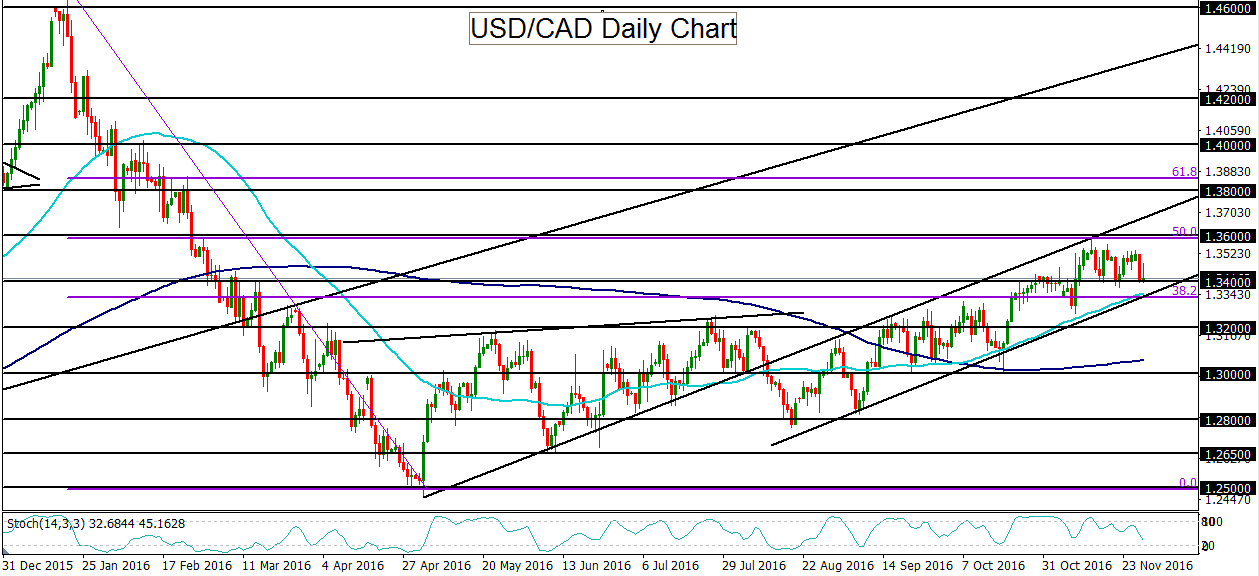Headline-driven crude oil prices have been fluctuating dramatically in the past few weeks as energy traders have been bombarded with various remarks and innuendos from OPEC nations regarding the organization’s proposed deal to cut oil production and boost prices. Formal OPEC talks will take place on Wednesday in Vienna, after which it should finally be revealed if a satisfactory deal was agreed upon or not. The implications of the meeting outcome are extensive, as the success or failure of a production deal will not only impact crude oil prices, but also global equity markets and the Canadian dollar.
With Canada’s currency having a strong correlation with crude oil prices due to the country’s reliance on its energy industry and exports, the outcome of the OPEC meeting will be especially relevant to the Canadian dollar. In recent days and weeks, serious doubts have continued to emerge regarding the likelihood of a successful deal agreement being reached among OPEC members, as member-nations continue to harbor long-held differences. In addition, some members (most notably Iran) have balked at participating due to extenuating circumstances, including previous sanctions and recent disruptions in production.
For the USD/CAD currency pair, Wednesday’s OPEC meetings will not be the only risk event on the agenda this week. Both the US and Canadian jobs reports will be released on Friday. The US data, otherwise known as non-farm payrolls, is expected to report around 165,000 jobs added for the month of November. With markets pricing-in a high probability (above 96%) that the US Federal Reserve will raise interest rates in mid-December, the US dollar has been well-supported as of late. If Friday’s jobs data falls somewhere around or above the forecast, there should be no change in the very high expectations for a December Fed rate hike. Only if the actual number falls far short of the forecast would there be a negative impact on the Fed’s December decision.
With the second half of this week packed with major risk events for USD/CAD, the currency pair has been bracing for some potentially significant movement. For the past three months, USD/CAD has been rising within a well-defined parallel trend channel as the US dollar has been showing persistent strength, especially within the last month, while the Canadian dollar has drifted steadily lower. Currently trading around the key 1.3400 level, USD/CAD could be heavily impacted by what happens both on Wednesday (OPEC) and on Friday (jobs).
From a technical perspective, a major downside trigger to watch would be the bottom of the parallel uptrend channel. Any breakdown below the channel, along with a breakdown below the nearby 50-day moving average, could open the way for a move back down towards the 1.3000 psychological support level. To the upside, the key level to watch continues to be around 1.3600 resistance. Any strong move above 1.3600 would extend the recent uptrend, pushing the currency pair towards its next major upside target around the 1.3800 resistance level.
With Canada’s currency having a strong correlation with crude oil prices due to the country’s reliance on its energy industry and exports, the outcome of the OPEC meeting will be especially relevant to the Canadian dollar. In recent days and weeks, serious doubts have continued to emerge regarding the likelihood of a successful deal agreement being reached among OPEC members, as member-nations continue to harbor long-held differences. In addition, some members (most notably Iran) have balked at participating due to extenuating circumstances, including previous sanctions and recent disruptions in production.
For the USD/CAD currency pair, Wednesday’s OPEC meetings will not be the only risk event on the agenda this week. Both the US and Canadian jobs reports will be released on Friday. The US data, otherwise known as non-farm payrolls, is expected to report around 165,000 jobs added for the month of November. With markets pricing-in a high probability (above 96%) that the US Federal Reserve will raise interest rates in mid-December, the US dollar has been well-supported as of late. If Friday’s jobs data falls somewhere around or above the forecast, there should be no change in the very high expectations for a December Fed rate hike. Only if the actual number falls far short of the forecast would there be a negative impact on the Fed’s December decision.
With the second half of this week packed with major risk events for USD/CAD, the currency pair has been bracing for some potentially significant movement. For the past three months, USD/CAD has been rising within a well-defined parallel trend channel as the US dollar has been showing persistent strength, especially within the last month, while the Canadian dollar has drifted steadily lower. Currently trading around the key 1.3400 level, USD/CAD could be heavily impacted by what happens both on Wednesday (OPEC) and on Friday (jobs).
From a technical perspective, a major downside trigger to watch would be the bottom of the parallel uptrend channel. Any breakdown below the channel, along with a breakdown below the nearby 50-day moving average, could open the way for a move back down towards the 1.3000 psychological support level. To the upside, the key level to watch continues to be around 1.3600 resistance. Any strong move above 1.3600 would extend the recent uptrend, pushing the currency pair towards its next major upside target around the 1.3800 resistance level.

Latest market news
Today 07:15 PM
Today 04:10 PM
Today 12:30 PM




